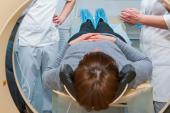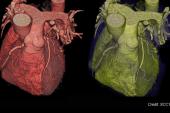As New Guidelines Loom, CT Community Seeks to Fill Knowledge Gaps
During a dedicated session at SCCT, cardiac imagers discussed hopes and holes in the long-awaited US chest pain guidelines.

A long-awaited update to chest pain guidelines in the United States is now expected for late summer or early fall, but whether the new advice will match the approach taken in Europe and the United Kingdom remains unclear.
At a dedicated session of the 2021 Society of Cardiovascular Computed Tomography (SCCT) meeting, cardiac CT enthusiasts bemoaned the protracted wait and aired their hopes and fears for the US update.
“The guidelines are coming and they will be there hopefully in August or September, so everybody is excited in the CT community to see the new guidelines and what the role of CT will be,” session chair Maros Ferencik, MD, PhD (Oregon Health and Science University, Portland), commented to TCTMD. What remains to be determined, he continued, is to what extent they will include the “evaluation of plaque burden and plaque, how is that going to fit into the overall prognosis, how we transition from understanding just stenosis or ischemia to long-term prognosis, and how do we share this with our patients.”
Acknowledging to TCTMD that this isn’t the first time in recent history an update to the multisocietal US guidelines has seemed imminent, Todd Villines, MD (University of Virginia, Charlottesville), who spoke during the session, said that “the US guidelines are extremely outdated: outdated to the point that they've really lost their clinical relevance.”
In 2016, the United Kingdom pushed coronary CT angiography (CTA) to the forefront of chest pain assessment with the National Institute for Health and Care Excellence (NICE) guidelines; the European Society of Cardiology (ESC) followed suit in 2019. This past February, the SCCT published its own expert consensus document promoting the use of coronary CTA as a stopgap until the American College of Cardiology (ACC) and American Heart Association (AHA) guidance is ready.
The last ACC/AHA guidelines were released in 2014 and list noninvasive functional testing as the default for assessing patients with stable ischemic heart disease. Coronary CTA remains a second-line test—an option for patients with contraindications to stress testing. An update has been rumored to be pending many times over the last several years, with TCTMD last reporting it would be out this past May. A spokesperson for the ACC confirmed to TCTMD that the update has been “pushed to late quarter 3 or early quarter 4” of this year.
Comparison of Guidelines
Jonathon Leipsic, MD (St. Paul’s Hospital, Vancouver, Canada), who attended the session, told TCTMD “it would be shocking if there wasn't class I support for CT [in the update] given the evidence.”
“The disparate nature of the guidelines and the need for them to sort of align a little more, particularly in the US, to sort of catch up with what is already well established in the literature or what's already well established in Europe and the UK will be really important,” he said, noting that it has been hard for those who want to rely more on coronary CTA to do so given the lack of reimbursement in the United States.
“As long as that's there's disconnect, it's harder for people to push for with regards to its adoption,” Leipsic said. “It's sort of this vicious cycle. With a class I indication, [the Centers for Medicare & Medicaid Services] in particular will have to look at this and appreciate that there's maybe a disconnect with regards to the reimbursement for different tests that's sort of driving the utilization of some rather than other tests.”
Villines believes many US physicians are already operating by the European and UK guidelines when they can. With the 2014 US recommendations, he said, “you would do stress ECGs as a first-line test, you would not do much coronary CT, and I think we're seeing people who really say the first question is: do you have known coronary disease?
“I think the European guidelines really get it right,” Villines continued. “They say if you don't have known coronary disease, it's great to start with a coronary CT. If you have known coronary disease, do functional testing. I think that's a good approach that many, like me, are practicing today. I think many people are already using the approach in the ESC guidelines. I anticipate you'll see the US guidelines look pretty similar.”
Jonathan Weir-McCall, MBChB (University of Cambridge School of Clinical Medicine, England), who outlined the effects of the NICE guidelines in the UK during the session, pointed out that even with new guidance, change comes slowly. “We’re still far away from the full implementation of them, with many barriers still to come” despite changes that started more than a decade ago, he said. “Part of this is building a bigger evidence base to satisfy referring clinicians about [CT’s] role in higher-risk [patients] and greater clinician engagement around this pretest probability score. Finally, we need to keep producing more hardware and more trained cardiac imagers.”
The biggest differences between current practice in the US versus UK and Europe relate to the inclusion of pretest risk assessment of obstructive disease, with US providers using models that tend to overestimate risk, Villines said. “The downstream consequences of that are that it often leads to perhaps overtesting, which has a societal economic impact. And often we know that we probably have contemporary assessments showing that previous measures did overestimate risk. I think the European guidelines have tried to remedy that by revising the pretest probability assessments.”
Acting on Information
In his talk, Villines noted that most guidelines “lump” all functional tests together, rather than singling out the best test for the patient. “Our guidelines don't do a great job in differentiating for clinicians when to choose the functional tests amongst the different options. That's really I think where guidelines can get better, and I think that's what we hope to see from future iterations. It will be interesting to see if the US guidelines try to tackle that.”
Additionally, Villines observed, guidelines need to better outline how to manage patients after they are tested. “Many guidelines kind of said ok, once you do a test it's either cath or don't cath,” he said. “But it's much more complicated than that. It's preventive therapy. It's how you counsel the patient. Should there be any further testing or not? And I think [in] the prevention role, these tests should be linked to changes in patient management, patient education, and clinician behavior.”
Leipsic, too, said one of his takeaways from the session was “that we need to continue to understand how to apply the right tests to the right patient, no doubt. We need to learn how to really titrate the use of cardiac CT and supplement it when appropriate with ancillary stress tests or [CT-based fractional flow reserve] to really optimally guide medical management and coronary revascularization decision-making.”
ESC President Stephan Achenbach, MD (University of Erlangen, Germany), who also spoke at the SCCT session, said the European guidelines still have room to improve and, like Ferencik , gave the example of plaque assessment. “The guidelines very much focus on the far end of coronary atherosclerosis,” he said. “The lesion that is stenotic causes ischemia and is therefore associated with a reduction in the risk of infarctions and the reduction in angina by revascularization and medication. Very little can be said about the earlier status of coronary atherosclerosis. There’s no mention of the relationship between plaque and statins, and this is something that we need to very intensively look at in the future.”
Even further down the line, Ferencik said, more data are needed for guideline updates to happen in 5 or 10 years’ time. “The speakers a couple times mentioned Danish studies that show us how strong CT is in predicting events, especially when you take plaque burden. That is only possible when you monitor almost 24,000 patients over a long period of time,” he explained. “We will need to create registries that will show us what's important in prognosticating and observing the patients, and we need randomized trials to actually then get into the guidelines.”
Also looking forward, presenter Ron Blankstein, MD (Brigham and Women’s Hospital, Boston, MA), said new evidence “requires us to rethink how and when we use imaging. And I’m saying ‘when,’ because not everybody needs an imaging test.”
But for those who do, “ultimately, we have to understand how to utilize the results of imaging tests in a manner which will impact patient outcomes,” he continued. “We have to state not just ‘Here is a test’ but how should a clinician act on the specific results.” The “next frontier” is linking imaging findings to therapy decisions that can actually “make a difference” down the road, said Blankstein.
Pivotal Questions
During a discussion at the end of the session, SCCT Immediate Past President Koen Nieman, MD, PhD (Stanford University, Palo Alto, CA), said the pivotal questions related to imaging are: “Who are we testing, which test do we use, and how do we incorporate it into management? And, of course, the last question should inform the first question.”
A key hurdle for the field is better understanding the pretest likelihood of finding enough disease on imaging to warrant a change in therapy, said Nieman. “One of the things that I struggle with is when I get patients in the clinic who on average have a pretty low pretest probability [of] less than 15%, . . . do I test them or not? They have been referred. Do I send them back? We want to avoid overtesting, but on the other hand we don’t want to send a patient back when there is a one in 10 chance that there is coronary artery disease. How can we improve that? Are the pretest probability algorithms good enough or should we use other things?”
Blankstein responded that “the pretest probability is reasonable but it’s not perfect, so you always have to look at other things. Calcium scoring is probably the most effective way to identify the truly low risk. So, it might just be a chest CT that was done for another reason [and then] if a patient has a calcium score of zero, that is incredibly useful but it’s certainly not always going to be available.”
Yael L. Maxwell is Senior Medical Journalist for TCTMD and Section Editor of TCTMD's Fellows Forum. She served as the inaugural…
Read Full BioSources
Villines TC. Coronary CTA in 2021 - What is the same, what is different, and what is missing in guidelines. Presented at: SCCT 2021. July 16, 2021.
Weir-McCall J. UK Guidelines - Did it change their practice NICEly? Presented at: SCCT 2021. July 16, 2021.
Achenbach S. European guidelines - Diagnostic principles in chronic coronary syndromes. Presented at: SCCT 2021. July 16, 2021.
Blankstein R. US Guidelines- Is the US catching up with the rest of the world? Presented at: SCCT 2021. July 16, 2021.
Disclosures
- Villines, Weir-McCall, Achenbach, and Leipsic report no relevant conflicts of interest.
- Ferencik reports receiving grants from the NIH and AHA and consulting for Biograft Inc.
- Blankstein reports receiving research support from Amgen, Novartis, and the NIH; serving on the steering committee for the Vesalius trial (Amgen); serving as a consultant to Roivant Services, Caristo Diagnostics, and Silence Therapeutics; and receiving royalties from UpToDate.





Comments